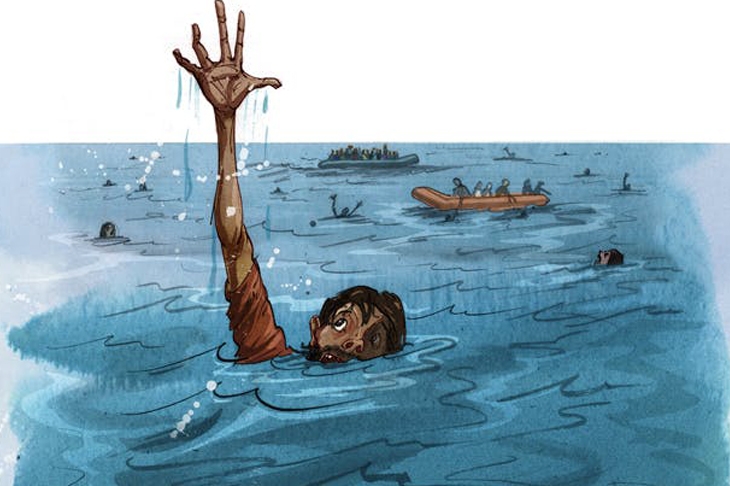The photographs of children in cages at US migration centres, apparently separated from the parents with whom they illegally entered the country, do not reflect well on the Trump administration. Talking tough on migration helped the President to win the election but there is a difference between building a wall and carrying out a policy which appears to use cruelty as a shock tactic.
Yet there is a policy towards migrants that is ultimately far crueller, and which is being pursued beneath our noses in Europe. That is to tempt migrants into unseaworthy boats to cross the Mediterranean.
Last year, according to the International Organisation for Migration, 3,116 people died attempting to reach European countries from North Africa by sea, in addition to 5,143 deaths in 2016. However demeaning the treatment meted out to Mexicans caught after a failed dash across the US border, it is not killing them.
European governments cannot claim they bear no responsibility for these deaths. Migrants are taking the risks because, in the vast majority of cases, their journeys are successful — and if they land, they probably get to stay. This is due to EU policy on migration.
For every life lost in the Mediterranean in 2016, there were 50 successful landings: a death rate of just 2 per cent. The Britons and Irish who emigrated to America in search of a better life faced far higher chances of dying yet were not deterred. If there is a 98 per cent chance of being able to start a new life on a more prosperous continent, it ought to be no surprise that so many take this risk.
The Italians have now had enough — of the deaths, and the logistics of handling the 690,000 who have landed on Italy’s shores over the past few years. Two weeks ago, Italy’s new government refused to allow a charity-run ship carrying 630 migrants to dock in its ports. A new government, a coalition between the Five Star Movement and the Northern League, was elected in part on a promise to stop Italy being used as Africa’s gateway to Europe. Under EU rules, migrants should be granted asylum in the first country they land — a policy that has placed a heavy burden on Italy and Greece.
It is to David Cameron’s credit that he recognised the most humane solution to the migrant crisis some years ago, at the height of the Syrian war: spend significant sums of money to help refugees in camps near the most affected areas, and take asylum seekers directly from their camps. His position was that Britain ought to play no part — directly or indirectly — in the booming business of people trafficking. As soon as a country grants residency to those who arrive at its shores, it becomes the unwitting partner of people traffickers. Norway has followed the British example, spending money on foreign aid and also on deportations. It regards this as a humane compromise, helping where it can, but refusing to facilitate an industry that smuggles human beings.
Angela Merkel took the opposite approach, admitting 1.4 million refugees and causing political mayhem in Germany. That move may yet finish her career. Spain could go the same way, having accepted almost a third of all those who crossed the Mediterranean this year so far. We can expect the people traffickers who were kicked out of the Aegean Sea two years ago now to target the Strait of Gibraltar. Last weekend, the Spanish maritime rescue service saved 986 people from smuggling boats. It also recovered four bodies.
Pedro Sánchez, the new Prime Minister of Spain, has said he has an ‘obligation to avoid a humanitarian catastrophe’. Quite so. But has the policy of accepting smuggled people not already led to catastrophe? This week, a group called United Against Refugee Deaths published a list of 34,361 people, whose deaths it blamed on the ‘restrictive policies of Fortress Europe’. Anyone seriously concerned about those deaths should ask if they are caused by the opposite: a system that makes the journey viable by accepting those who complete it.
When Australia faced a similar refugee crisis at the start of this century, its government responded by adopting a policy of turning back boats. The death toll then collapsed. When this policy was reversed, seven years later, more than 50,000 people arrived in such boats, of whom 1,000 perished. It was a revulsion against these deaths that led the Australian government to recognise that accepting the boats, while well-intentioned, also caused deaths.
Earlier this year, the Social Democrats in Denmark — generally thought of as one of Europe’s most liberal countries — proposed sending asylum applicants to be processed in an overseas centre. So rather than travelling to Europe to claim asylum, would-be refugees would be able to make their applications at centres in North Africa. If successful, they would be taken to Europe in safety. The option of evading the authorities, and slipping into an underworld, would be taken off the table.
We can only hope that European policy might progress in the right direction: moving the asylum system closer to the refugees and being tougher on migrants who arrive on European shores. A humane asylum system need not involve caging children but it should reduce the incentive for migrants to undertake deadly journeys.






Comments